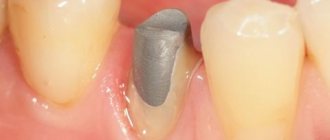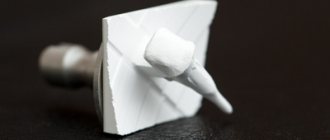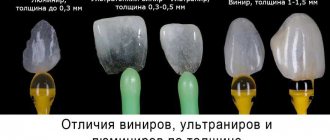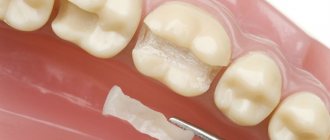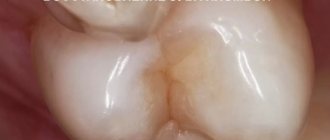Sometimes patients ask dentists: which is better, a pin or an inlay, and what is better to restore a damaged tooth? Despite the fact that these structures are somewhat similar and are intended for the same purpose - restoring severely damaged teeth while preserving their own roots - they still have a number of differences. To make it easier for the patient to decide, we will analyze the pros and cons of pins and inlays.
Content
- Details about the pin
- Details about the tab
- Materials for production
- What the inlay and pin have in common
- Differences
- What to choose - pin or tab
Currently, dentists offer many options for prosthetics and dental treatment. Modern technologies can solve almost any problem. It is important to choose the best option for a particular case. If treatment of a decayed tooth is required, the choice is between an inlay and a pin.
PROMOTION
Dental restoration, installation of fillings
from 2200 rub.
Dental care after the installation of a core tab
Stump inlays do not require complex specific care. All you need to do is maintain oral hygiene, brush your teeth regularly and undergo periodic dental examinations and professional hygiene procedures.
To clean crowns installed on teeth with core inlays, it is best to use brushes with soft bristles; it will also be useful to rinse your mouth after each meal - with a special balm or just clean water. When brushing your teeth, it is important to clean them from all sides and be sure to thoroughly clean the interdental spaces. For this purpose, special brushes and dental floss are used.
Pin
This is a rod installed in the root of the tooth to strengthen it and ensure subsequent treatment. It is installed when there is severe destruction, when no more than half of the root remains. The materials used for manufacturing are polymers or metals. A serious disadvantage of metal pins is the need to greatly expand the root canal, as a result of which its strength decreases. Fiberglass pins do not have this drawback and are similar in characteristics to natural dentin.
When choosing a manufacturing material, we proceed from specific requirements:
- For prosthetics of the front teeth, fiberglass is used;
- Metal products are intended for chewing units with severe destruction;
- Carbon fiber is a universal option, suitable for any teeth.
There are two types of fastening:
- Passive – on dental cement, without load on the root;
- Active - the pin is screwed into the root using a thread.
Anchor pins
A great variety of anchor pins are used in dentistry:
- by material of manufacture: titanium, steel, brass, fiberglass;
- according to the method of fixation: active (with an active sharp thread, like a self-tapping screw), passive (smooth, stepped ribbed) and something in between (with a smooth blunt thread);
- in shape: cylindrical and conical (with different tapers);
- In addition, each manufacturer produces pins of its own original design in different sizes and claims that its pins fit all pins.
But such diversity does not confuse dentists. Anchor pins appeared on the Russian market quite a long time ago, and each of us already clearly understands the indications and contraindications for this or that type of pin. Anchor pins significantly expand the dentist’s capabilities and can be used both for tooth restoration using photopolymer material, and for restoring the “stump” of a tooth for a crown.
Tab
This is also a prosthetic design that imitates part of a tooth. Used for teeth located behind the canine teeth.
There are:
- Restorative inlays - to recreate the correct shape, bite and natural shade of the tooth;
- Stump inlays are placed under the crown and serve as the foundation for it.
The difference from the pin is in the device - the inlays consist of two parts - the pin itself and an element that replicates the tooth. The manufacturing process takes place under pressure at high temperatures. The root part is an attachment for the root and looks like a rod. The upper element follows the shape of a crown.
Comparing methods: which is better - a stump tab or a pin
So, the question arises, which is better - a stump or a pin? We conducted a brief analysis by comparing the advantages and disadvantages of both prosthetic methods. All characteristics, pros and cons are placed in the table for convenience.
| Pin | Stump tab | |
| Number of doctor visits | 1 visit | 2 visits – during the first, impressions are taken and the tooth is prepared |
| Manufacturing | Pins are template structures | Inlays are created individually in the laboratory |
| Materials | Alloys of inexpensive metals | Ceramics, metal alloys, precious metals, zirconium dioxide |
| Possibility of developing allergies | High | Low, since hypoallergenic materials can be selected |
| Possibilities of prosthetics | The crown is built up on a post using composite materials | Various materials are used: composite building, or crowns (metal-ceramics, ceramics, zirconium dioxide) |
| Aesthetics of prosthetics | Medium – the metal base will be visible, the extended tooth will be noticeably darker | Very high due to the exact repetition of tooth anatomy and the choice of snow-white aesthetic materials |
| Main advantages | Affordable price, possibility of crown repair directly in the patient’s mouth | Root protection from destruction, high aesthetics, long service life |
| Main disadvantages | Rapid destruction of the root under load, relative aesthetics, short service life | High price |
| Life time | No more than 3-5 years | From 3-5 years and above |
| Price | From 4-5 thousand rubles including extensions | From 10 thousand rubles + crown |
To summarize, then, of course, it is worth giving preference to stump inlays. Such dentures ensure the reliability and functionality of the restored tooth. They can last for decades and the tooth will look like a natural one. But inlays are noticeably more expensive, so you need to make a choice primarily based on the condition of the tooth and your budget.
Material of manufacture
A variety of materials can be used, including:
- Metals and composites are the most popular option, they are easy to manufacture, durable and have an affordable price;
- Ceramic - similar to natural tooth enamel, the most aesthetic option;
- Zirconium - combines the best qualities of the previous options - they are aesthetically pleasing and durable, but are not very popular because they are very expensive.
Design Features
A stump inlay is a structure made from a patient’s dental impression for attaching a crown. This type of denture is a combination of cast material of different alloys. The prosthesis is installed into the dental canal from the inside to strengthen the damaged dental crown.
A stump tab is the only way to restore a maximally damaged tooth (more than 70%).
The upper part of such a prosthesis looks like the stump of a ground tooth, which is where the name “stump” comes from. For special strength, the prosthesis is made by casting from various metal alloys.
This prosthetic model is not a crown. This is a completely different structure. It is difficult to do without this extremely reliable type of prosthetics in modern dentistry.
Stump tab, pin and crown: which is better
It is impossible to compare core inlays and crowns. These are prostheses of fundamentally different purposes, properties and configurations. And only the dentist can decide which type of prosthetics is preferable for a particular patient.
However, a core inlay is not used for teeth with very thin walls. In this case, a crown can more effectively cope with the task of strengthening the crown of the tooth. The crown will be especially strong if it is attached to the stump tab. At the same time, it is possible to maximally strengthen even the most worn teeth and completely restore their natural chewing function.
Both the post and core support strengthen damaged teeth. However, this type of prosthesis guarantees super-strength dental fasteners, uniform chewing load and protection from further destruction.
A very important advantage of the inlay is its fastening using a cement composition. This guarantees a tight fit to the tooth of any degree of wear and prevents the formation of cracks.
Differences
- The pin puts pressure on the root of the tooth, which can cause it to become loose; there is pressure on adjacent teeth, and the inlay eliminates this load.
- Time of use - the pin can be used for up to 3 years, the inlay - much longer, almost 10 years.
- The pin is a single design, but the tab can separate.
- It is not difficult to make a pin, but to make an inlay, laboratory specialists are involved and special studies are carried out.
- The installation of the pin is carried out in one visit to the dentist; to install the inlay, you will have to visit the doctor at least twice.
- If the tooth has a crooked root, you can only use an inlay.
- The cost of an inlay is significantly higher than a pin.
- Preparing the tooth for the installation of a pin is relatively gentle; in order to install the inlay, a large amount of tissue is removed.
How stump inlays are made: an overview of the main stages
Stump inlays are made individually for each patient. Treatment begins with an examination of the patient and consultation with two specialists – a general dentist and an orthopedic dentist.
Before an impression is taken from the tooth, according to which a stump insert will be made, high-quality sanitation of the oral cavity is carried out, and all diseases of the teeth and gums diagnosed during the examination are treated. The damaged tooth is treated: the nerve (pulp) is removed from it, and the canals are filled. This is where the work of the dentist-therapist ends and the orthopedist begins to care for the patient.
Further treatment will proceed according to the following scheme:
- The prosthetist will correctly prepare the tooth for installation of the stump inlay and select its type.
- When choosing the type of stump tab, the material of its manufacture and the type of tab (single-root or multi-root, cast or collapsible stump tab) are determined.
- Then the doctor will make an impression of the patient’s jaws, which will be sent to the dental laboratory, where a stump inlay will be made from the impression taken.
- Based on the impression, a model of the stump inlay is first made, and then a permanent structure is made from the selected material.
- The dental technician passes the finished stump inlay to the orthopedist.
After the stump inlay is ready, the patient is invited to the prosthetist’s office and the doctor installs the stump inlay in the tooth canals. A temporary prosthesis is put on the tab and a break is taken in the treatment until the crown is made, which the doctor fixes on the stump tab.
Minuses
Like any other type of prosthesis, the stump tab has some disadvantages in technology and manufacturing time:
- High cost and longer production time (requires several visits to the orthodontist).
- Duration of treatment (preparatory stage for installing the “inlay + crown” complex after the second visit to a specialist).
- Cutting down a significant amount of bone and tissue for maximum docking during installation.
Advantages of stump inlays
- maximum reliability of the “root - stump - crown” system;
- proportional load on the tooth when chewing;
- service life of the structure.
A number of indications have been developed for the stump inlay. Its use is possible:
- in case of abnormal location or formation of a tooth;
- with seriously damaged teeth (more than 70%) in the coronal part;
- if it is necessary to strengthen the tooth before installing a crown;
- in cases where it is impossible to restore the crown using other methods (filling, etc.);
- for supragingival dental defects of any origin;
- for supporting a bridge (for strengthening);
- in a situation of preserving a sanitized dental canal;
- for splinting in case of periodontal pathologies.
Price
The stump model of the prosthesis is not a cheap dental structure. Its cost may vary from one dental office to another. The most inexpensive is the metal model (on average from 2,000 to 3,000 rubles). A prosthesis made of pressed ceramics costs about 12,000 rubles. And most of all you have to pay for the zirconium dioxide inlay (about 15,000 rubles).
If your tooth is damaged, but its root is not damaged, do not worry! Modern designs in the form of a stump tab will help you preserve and strengthen a hopeless tooth.
Sources used:
- I. Yu. Lebedenko, Orthopedic dentistry, 2012
- Seifollahi M. Preparation of lateral teeth for all-ceramic inlays
- https://medicine.wustl.edu/

